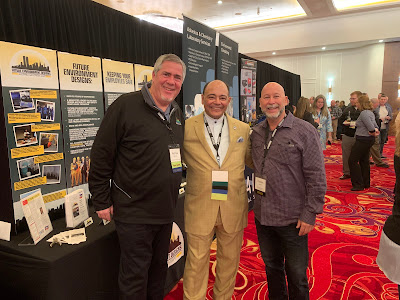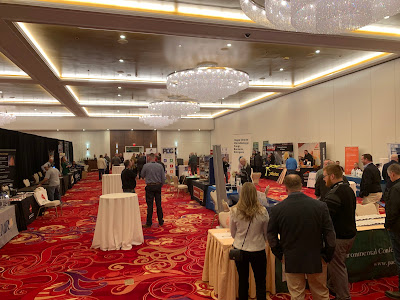The second day of the 27th Annual Environmental Conference hosted by the Professional Abatement Contractors of New York (PACNY) at Turning Stone Casino continued to deliver valuable insights and critical updates for industry professionals. As a Sapphire Sponsor, Future Environment Designs, Inc. was proud to be part of this informative and engaging event.
 |
| Long Island Contingent - Matthew Brooks, IAR and Chuck Merritt, Merritt Environmental Consulting |
State of PACNY: Leadership Insights and Organizational Updates
The day began with an address from Kevin Hutton, PACNY President, and Craig Kaputa, PACNY Past President, who provided an overview of the state of PACNY. Their presentation highlighted the organization's accomplishments over the past year, ongoing initiatives, and future goals. The duo emphasized PACNY's commitment to advancing industry standards and supporting its members through education, advocacy, and networking opportunities. Angelo Garcia, III was honored by receiving the PACNY's President Award for his efforts in handling the LinkedIn postings for the conference, sitting on the conference planning committee, and participating as a Board Member.
 |
| Kevin Hutton, PACNY President and Craig Kaputa, PACNY Past President Awarding Angelo Garcia, III the President's Award |
Interactive Keynote: Navigating an OSHA Inspection
The keynote speaker, Mike Rubin of Ogletree Deakins, delivered an impactful and interactive session, "An Interactive Walk Through an OSHA Inspection." Rubin's presentation was a deep dive into the intricacies of handling OSHA inspections, focusing on key points that every employer must know:
- Know Your Rights: Employers should be well-versed in their rights during an OSHA inspection to ensure they are adequately prepared.
- Scope of Inspection: It is crucial to verify that OSHA's requests are within the scope of the inspection to avoid unnecessary overreach.
- Cooperate But Be Informed: While cooperation with OSHA inspectors is essential, employers should remain informed and vigilant about their rights and obligations.
- Document Requests in Writing: Employers should always request that OSHA put their document requests in writing to maintain clear and accurate records.
Rubin's interactive approach, including role-playing scenarios, allowed attendees to gain practical knowledge and confidence in managing real-life OSHA inspections.
 |
| Keynote Speaker Michael Rubin of Ogletree Deakins |
Vendor Exhibition and Networking: Engaging with Industry Leaders
Following Rubin's session, attendees had the opportunity to network and explore the vendor exhibition hall during the final coffee break. The exhibition hall was bustling with activity as professionals connected with vendors, discovered the latest industry products, and shared experiences and insights.
 |
| Vendor Exhibit Hall |
NYSDOL Presentations: Streamlining Processes and Introducing New Capabilities
The late morning session featured a series of presentations from key representatives of the New York State Department of Labor (NYSDOL) Asbestos Control Bureau. Matthew Robinson-Loffler, Deputy Director of the Division of Safety and Health, began by highlighting improvements in the licensing process for asbestos and mold professionals. He noted that filing applications through the MPWR website ensures that paperwork is handled by department personnel within 24 hours, significantly speeding up the turnaround time for obtaining licenses and certificates.
 |
| Matthew Robinson-Loffler - NYSDOL Deputy Director of Division of Safety and Health |
The most significant announcement from NYSDOL was the introduction of online variance filing through the MPWR website. Chek Beng Ng, Program Manager of the Engineering Services Unit, provided a detailed walkthrough of the new variance filing process. He demonstrated how to navigate the system and submit variance requests efficiently. Chek Beng Ng also addressed numerous questions from attendees, clarifying various aspects of the process. It was evident that while the new online system is a work in progress, it represents a significant step towards streamlining administrative procedures.
 |
| Chek Beng Ng, NYSDOL Program Manager of the Engineering Services Unit |
Kirk Fisher, Program Manager of the Asbestos Control Bureau, concluded the NYSDOL presentations by reinforcing the importance of compliance. This year we had one of the highest attendances from the different District Offices of NYSDOL's Asbestos Control Bureau.
 |
| NYSDOL Asbestos Control Bureau Attendees |
Networking Lunch: Building Connections and Fostering Collaboration
The conference concluded with a networking lunch, offering attendees a final opportunity to engage with peers, discuss the day's insights, and establish new connections. The collaborative atmosphere fostered by PACNY's conference emphasized the importance of community and shared knowledge in advancing the environmental industry.
As we reflect on the second day of PACNY's 27th Annual Environmental Conference, it is clear that the event successfully provided valuable updates, practical knowledge, and opportunities for professional growth. Future Environment Designs, Inc. looks forward to continuing our involvement with PACNY and supporting the industry's ongoing efforts to enhance safety, compliance, and innovation. We look forward to seeing everyone at the 28th Annual Environmental Conference on February 27th and 28th, 2025.
































